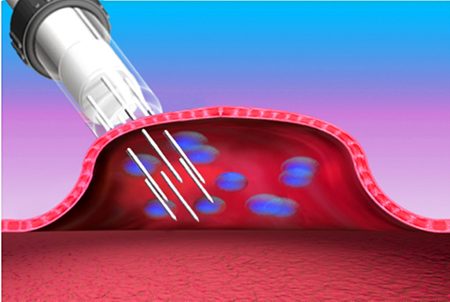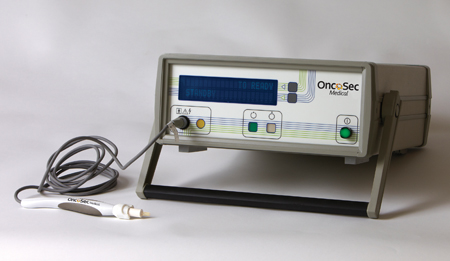Delivering therapeutic agents into the cells of cancerous tumours presents a challenge. Punit Dhillon* and Michael Cross**, OncoSec Medical, review the next-generation of targeted and novel approaches to the treatment of solid tumours.
At some point in their lives, one in five people will suffer from skin cancer, and the proportion is rising steadily. In spite of innovations in sunscreen technology and growing public awareness of the need to be shielded from the sun, data reported recently in Dermatology Times show a rise in the average American lifetime risk of one deadly skin cancer variety – invasive melanoma – from 1/600 in 1960 to 1/50 in 2008. Despite better and earlier diagnosis and innovations in approaches to treatment, the age-adjusted number of annual deaths per 100,000 population is still rising. Additionally, the expense to the healthcare system and society continues to increase.
As US and European populations age, the incidence and prevalence of skin cancer and other solid tumour cancers will continue to grow. According to the latest US cancer statistics, published by the Centers for Disease Control and Prevention in 2007, the top 10 cancer types (based on incidence rate) are in the solid tumour category; today the priority is probably even higher. Thus, there are clear medical needs that remain unmet and the creation of novel, cost-efficient and patient-friendly treatments therefore remains a top priority for the healthcare community and patients alike.
The treatment of skin cancers, which range from melanoma and Merkel cell carcinoma to cutaneous T-cell lymphoma, continues to be a substantial challenge for physicians. For example, in spite of innovations in drug discovery and development, it is still challenging to simply deliver drugs into cancer cells in a safe and effective manner. Meanwhile, today’s other non-chemotherapeutic approaches – involving surgery and radiation therapy – each have significant drawbacks, including pain, disfigurement and a negative quality of life impact and are cost-disadvantageous.
in spite of innovations in drug discovery and development, it is still challenging to simply deliver drugs into cancer cells in a safe and effective manner
Surgery, the current first-line treatment for localised and operable tumours or lesions, requires resecting the tumour mass and a surrounding boundary of healthy tissue to make sure that no cancer cells remain at the tumour site. Surgery can potentially cause physical disfigurement or debilitating effects on organ function, and it has been demonstrated that patient quality of life is negatively affected. Also, surgery can require an expensive and long hospital stay.
Radiation therapy is occasionally used in conjunction with surgery to shrink a tumour prior to surgical removal, or afterwards to destroy any cancer cells that might remain. Yet surgery plus radiation can damage important normal tissues. Radiation is also a costly therapeutic approach, and requires substantial expertise, precautionary measures and infrastructure to administer. It also entails complications, such as nausea, diarrhoea, dry mouth, taste alterations, loss of appetite, and importantly the potential for the formation of new cancerous lesions.
Typically, chemotherapy is a secondary or palliative treatment to help mitigate systemic or metastatic tumour growth, whereas surgery and radiation may be considered local treatments. As a cancer spreads, physicians will administer chemotherapeutic agents that circulate throughout the body, systemically and in high concentrations, to counter the challenge that some chemotherapeutic agents have in reaching and penetrating tumours. Yet the system-wide use of chemotherapeutics frequently has major side effects by killing healthy as well as cancerous cells.
This systemic and non-targeted administration of anticancer agents can trigger immuno-suppression, drug resistance, alopecia, nausea and vomiting. Chemotherapy is curative for only a few tumour types.
Newer approaches to treating cancer have been developed that harness the body’s own immune system to recognise and destroy cancer cells
Newer approaches to treating cancer have been developed that harness the body’s own immune system to recognise and destroy cancer cells. Approved immunotherapy agents, such as interferon and interleukin-12, have been employed to treat a variety of solid tumours, including skin cancer. However, the accompanying severe side-effects have limited the effectiveness of these agents. New immunotherapies are now in development that target specific components of the body’s immune system, such as antigens, receptors or regulatory proteins. The challenge for these new agents is developing an effective and efficient delivery vehicle that will avoid the need for intravenous systemic administration, while still being able to deliver a potent payload of the agent directly to the tumour.
potential new approaches
The basis of cancer immunotherapy is to stimulate the patient’s own immune system to recognise and attack the malignant tumour cells, which have managed to circumvent the body’s natural immune processes that would normally recognise and destroy these cells before they are able to form growing cancerous tumours. Several methods have been employed to evoke this immune response, including vaccination using tumour specific antigens, or monoclonal antibodies, and cell-based immune therapies that activate immune cells, such as cytotoxic T lymphocytes (CTLs) and dendritic cells (DC) to fight against the cancer.
Despite the demonstrated benefit to some patients by extending life beyond traditional therapeutic options, safety and tolerance to these drugs, as well as ease of administration of the therapies, has been a deterrent for adoption into the clinic. As a result, emerging therapies continue to be developed to improve upon the safety, efficacy and ease-of-use problems currently encountered by immunotherapies.
Recently, a new therapy for the treatment of prostate cancer was approved that employs an autologous cell-based mode of delivery. It involves the harvesting of a patient’s own cells, growing them in a lab setting, incubating with a vaccine or immune stimulating agent, and re-administering the resulting product into the patient. This autologous cell-based approach has shown safety and efficacy, yet the significant cost and time involved in preparing this therapeutic approach for each individual patient has proved unattractive for many clinicians.
Viral vectors, such as adenoviruses and oncolytic viruses, have also been developed to deliver immunotherapeutic payloads either systemically or through direct injection into the tumour
Viral vectors, such as adenoviruses and oncolytic viruses, have also been developed to deliver immunotherapeutic payloads either systemically or through direct injection into the tumour to fight the cancerous cells. While no approved therapies are currently available, clinical trials for this approach are ongoing.
Questions remain about the efficacy of viral vectors as a delivery method, since the patient may develop an immune reaction against the virus itself, resulting in neutralisation of the virus and clearance from the body before a beneficial response is elicited. Since viral vectors are occasionally created from pathogenic viruses, involving a deletion of a part of the viral genome critical for viral replication, safety has also been a concern to avoid production of new virions.
Other non-viral vector methods, including liposome-based delivery systems, are also currently being developed and employed in ongoing clinical trials. The impact of these emerging cancer immunotherapies will ultimately be determined by their ability to improve upon the safety, efficacy, utility and cost of currently available therapies.
Yet another promising strategy for delivering agents to solid tumour cancers involves targeting the tumour itself without affecting any of the surrounding healthy tissue. One such targeted therapy harnesses the physiological process of ‘electroporation’. Derived from the words ‘electric’ and ‘pore’, this approach involves applying a brief electric field to the cancerous cell. The electrical pulse triggers the temporary creation of pores or channels in the cell’s outer membrane that close again once the electric field is discontinued. These transient pores dramatically improve the cellular uptake of drugs by more than a thousand-fold.

Tissue electroporation enhances cellular uptake
Several electroporation systems have been manufactured that consist of a generator that creates the pulsed electric field, and various handheld applicators with electrode needles that contact the cell target. The applicator delivers a controlled electric pulse to the cancer cells, thus causing any cell within the affected region to undergo electroporation. The cell then takes up previously administered therapeutic agents within the region of the electroporation.
Among the leaders developing this technology, OncoSec Medical of San Diego, California, has designed its electroporation platform for use in two different anticancer therapeutic approaches: ElectroChemotherapy and ElectroImmunotherapy.
electrochemo approach
In the ElectroChemotherapy approach, an anticancer drug is injected into a targeted tumour; the lesion is then electroporated and the drug carries out its planned mechanism of action in killing the cell. As a result of the targeted, local therapy, the amount of drug needed to kill the cells is substantially less than that required in traditional, non-targeted intravenous chemotherapy. The lower quantity of the systemic drug (cytotoxic agent) eliminates or significantly reduces any harmful side-effects linked to traditional chemotherapy.
electroimmumo approach
ElectroImmunotherapy, the other application of OncoSec’s electroporation platform, involves the local administration of a gene encoding for a specific cytokine, a natural protein that regulates the immune system against cancer cells. OncoSec has demonstrated that an immune response generated by local Electro-Immunotherapy can have both a local and a distant effect against cancerous cells. These therapeutic approaches have been shown to be safe and effective across various types of tumours.

The OncoSec Medical System is designed to use the power of electroporation to increase the cellular uptake of therapeutic agents
Researchers at the University of Washington and University of California-San Francisco are currently engaged in three Phase II clinical trials targeting three types of deadly skin cancers using OncoSec’s electroporation technology delivering a cytokine gene. The first trial, in Washington, is focusing on Merkel cell carcinoma. In San Francisco, the second trial will target advanced metastatic melanoma while another trial is treating subjects with cutaneous T-cell lymphoma.
Therapies such as those discussed here may provide a compelling set of novel approaches to the treatment of solid tumour cancers and provide both safety and efficacy advantages over traditional therapies.
*Punit Dhillon is president and ceo of OncoSec Medical Inc., a biotechnology company developing its advanced-stage Oncology Medical System (OMS) Electro Oncology therapies to treat skin cancer and other solid tumour cancers.
**Michael Cross, Ph.D., is chief business officer of OncoSec Medical Inc.




